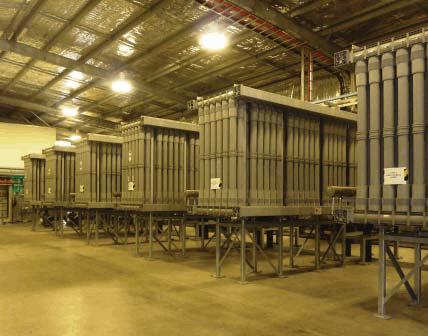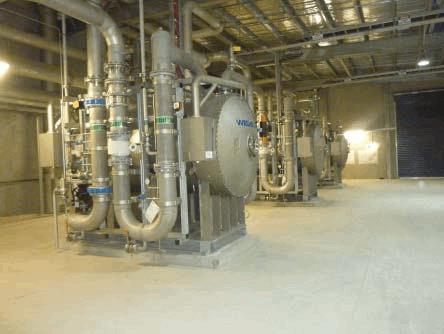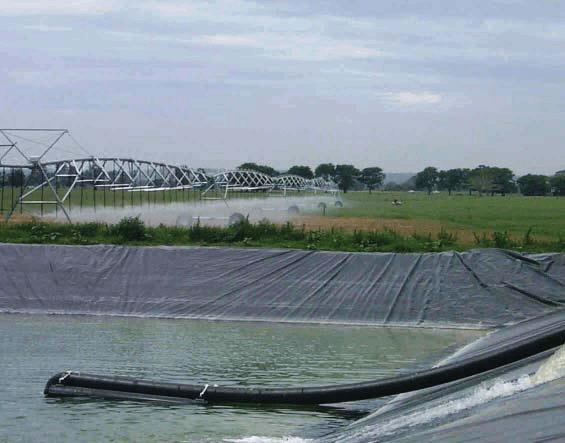Down Under On Top: Lessons In Water Recycling From Australia
By John Radcliffe
More than a decade before the U.S. West’s historic drought, Australia had to solve an even longer, drier spell. What can we learn from their experience?
Australia is a federation of six states and two territories, each with its own government, independent of the Australian government. Water is constitutionally a states/territories matter. In most states, water supplies are undertaken by state-owned corporations, though in regional New South Wales and in Queensland, these services are generally provided by the third tier of government — local government. Wastewater services are usually operated by water supply organizations. Stormwater systems are universally separated from wastewater systems. Over the years, the Australian Federal and state/territory governments have jointly agreed on a series of innovative water policies that have provided a firm foundation with a common understanding among governments.
National Strategy
Australia commenced developing its National Water Quality Management Strategy over 30 years ago. The strategy has resulted in the production of 24 guidelines encompassing drinking water; freshwater and marine water quality; groundwater protection; sewerage systems, including effluent management, trade wastes, and biosolids; effluents from agricultural industries (dairies, piggeries, wool scouring, tanneries, wineries, and distilleries); and water recycling (managing health and environmental risks, augmentation of drinking water supplies with recycled water, the use of stormwater, and managed aquifer recharge). All these guidelines are then able to be adopted into states/territories legislation and regulations for enforcement by Environment Protection Authorities and Public Health Departments.
Local Agreements
Uniform policies for Australia’s urban and rural water resources were brought together between the Federal and states/territories governments in the Intergovernmental Agreement on the National Water Initiative in 2004. This encompasses clauses on water entitlements and the equitable sharing of water allocations in proportion to those entitlements, water markets and trading, water pricing, management of environmental water, national water accounting, urban water, and community partnerships, together with knowledge and skills. It has objectives of ensuring healthy, safe and reliable water supplies; increased domestic and commercial water use efficiency; facilitating water trading between and within the urban and rural sectors; encouraging innovation in water supply sourcing, treatment, storage and discharge; achieving improved pricing for metropolitan water and establishing a national water accounting system. As a result, there is virtually no litigation over water rights issues in Australia.
The agreement included the development of national guidelines for water-sensitive urban development in housing subdivisions and high-rise buildings, incorporating the integrated design of the urban water cycle, water supplies, wastewater, stormwater and groundwater management, urban land use design, and environmental protection.
Historic Drought
From about 1996, Australia entered a long period of belowaverage rainfall, known as the “millennium drought.” The drought reached an apogee around 2006 when harsh water restrictions — accompanied by community awareness programs — were in place in all mainland capital cities and for most of irrigated agriculture. Most of the community responded positively to these challenges and per capita consumption has remained lower since the end of the drought. The importance of the water market was demonstrated when rice growers, rather than planting their rice, found it more profitable to sell their annual water allocations to farmers growing more valuable crops in horticulture. An established and consistent policy framework served Australia well.

Figure 1. Adelaide, capital city of South Australia, was established in 1836 with a unique set of parklands around what is now the central business district. The dry Mediterranean climate meant the parklands were dry and brown in summer, and for many years were burned off annually. Recycled water from the Glenelg wastewater treatment plant is now reticulated throughout the parklands for irrigating sporting fields and gardens. (Credit: South Australian Water Corporation)
Solutions That Worked
The drought encouraged widespread uptake of water recycling from urban wastewater treatment plants for use on high-value irrigated crops in Sydney, Melbourne, and Adelaide. In some cases, the recycled water was mixed with limited supplies of mains (public) water, stormwater, or groundwater to reduce the salinity of the recycled water.
Dual reticulation systems were installed in new suburbs, the first being Rouse Hill in Sydney. Similar developments followed in Brisbane, Melbourne, and Adelaide, the recycled water being delivered in separately identified “purple pipes” and available for toilet flushing, car washing, garden watering, etc. Ensuring there were no cross connections between the two systems was essential and required disciplined inspections. Many high-rise office buildings and apartment buildings include wastewater recycling plants for redistribution of recycled water for reuse within the building. This contributed to such buildings achieving high “Green Star” environmental accreditation, thereby being able to secure higher rents to offset the additional capital cost of fitting the buildings with dual reticulation. The Melbourne City Council, Sydney Water, Melbourne Water, and the South Australian Water Corporation were among leaders with new buildings that were both energy- and water-efficient. Recycled water has also been returned to rivers to add to environmental flows, offsetting water removed upstream. Managed aquifer recharge began to be introduced for the storage of recycled water until needed, responding to the minimal winter/peak summer demand for irrigation water for public parks and amenities. Some systems used reverse osmosis (RO) and advanced oxidation processes (AOP), while others used ultrafiltration (UF). An interesting example was the UF system installed in Adelaide’s Glenelg Wastewater Treatment plant, the recycled water being piped to Adelaide Airport and also the Parklands, which surround Adelaide’s Central Business District.
Municipal Investment
In 2004, a Water Smart Australia program was announced. This provided for investment in the conservation and more effective utilization of water resources. “Diversity of supply” through the provision of alternative water sources became the new driver. The Federal government contributed financially to recycling and desalination initiatives to “accelerate the development and uptake of smart technologies and practices in water use across Australia.” Within two years, 48 percent of the investment had been directed towards water recycling projects. Some projects were developed in “near emergency conditions.” Ultimately, the program ran until June 2012, supporting 78 projects with total costs of AUD$5 billion, $1.5 billion of which came from the Federal government.
Following the unprecedented water restrictions having been introduced in all mainland capital cities, seawater desalination plants were urgently developed for Perth (2), Sydney, Adelaide, Queensland’s Gold Coast, and Melbourne. These plants, with a total annual capacity of 530 gigaliters (GL) — roughly 120 billion gallons (BG) — involved a variety of design, funding, and technical development methods, but all were fundamentally dependent on RO. The Queensland government developed Advanced Water Recycling Plants adjacent to Brisbane Waste Water Treatment Plants at Bundamba, Luggage Point, and Gibson Island, with a capacity of 84 GL (19 BG) per year. The scheme, known as the Western Corridor Scheme, was based on the manufacture (as it was described) of purified recycled water by microfiltration (MF), RO, and AOP. The recycled water was to be pumped as “indirect potable” to the Wivenhoe Dam. A portion of the flow was to be used for cooling at two power stations which were then using 10 percent of Brisbane’s daily drinking water consumption. Brisbane’s water resources were linked together with the Gold Coast desalination plant to form a water grid. The whole project was completed urgently within two years and involved constructing 208 km (129 miles) of pipelines.

Figure 2. The Glenelg Wastewater Treatment Plant generates recycled water with these ultrafiltration modules followed by advanced oxidation (UV and chlorination) with the consequent saline stream piped to the much larger Bolivar plant for further treatment.
Lessons Learned
Unfortunately, most of these projects came to fruition as the drought came to an end with localized but widespread flooding in 2010. The Wivenhoe dam filled to 200 percent of water storage capacity as the “head space” served as a flood control dam. Hence, the Western Corridor Scheme has never been used for its intended purpose of supplementing Brisbane’s water supply, and the Advanced Water Treatment Plants are now closed. With hindsight and with secured public acceptance, it might have been much cheaper to use the product water as “direct potable” to the nearby Mount Crosby Water Treatment Plant. The Gold Coast, Sydney, and Melbourne desalination plants have never had regular use, though 50 GL (11.4 BG) of water has been ordered from the Melbourne plant for 2016. The two Perth desalination plants have been in full operation since constructed; that in Adelaide has been kept running at 10 percent capacity. The investment in alternative water sources (some would say too generously) has had an impact on the capital management and costs of water utilities. The Victorian Auditor-General observed in 2013 that interestbearing liabilities had increased from 2009 to 2013 by 248 percent in that state, with interest representing 21 percent of total operating costs. Servicing the debt and repaying it are now major challenges for the water industry in Australia’s capital cities.

Figure 3. Melbourne Water uses these ozone generators as components for treating secondary effluent at its Eastern Treatment Plant at Carrum, using a pre-ozone/biological media filtration/postozone/UV/chlorine process train to improve discharge quality and produce water suitable for horticultural irrigation and potential third (purple) pipe domestic use.
Future Focus
Towards the end of the drought, the Federal Government established the National Urban Water and Desalination Plan to “reduce reliance on rainfall dependent sources by supporting infrastructure projects and research in desalination, water recycling, and stormwater harvesting and reuse.” This program included funding of research over five years for a newly created National Centre for Excellence in Desalination (NCED) in Perth and an Australian Water Recycling Centre of Excellence (AWRCoE) in Brisbane, each supported with AUD$20 million, to which additional funding was added by co-investment from governments, research agencies, and water utilities.
The National Centre for Excellence in Desalination had objectives of leading and coordinating national research in energy-efficient desalination technology, building national capacity and capabilities in desalination, and to advance the science of desalination with specific application to Australia’s unique needs and challenges.
The Australian Water Recycling Centre of Excellence had four goals: incorporating new technologies; establishing a national validation framework for elements of water recycling; having recycled water accepted for drinking; and developing a national knowledge base for recycled water.
Industrial/Decentralized Reuse
Initially, a summary of learnings from already-introduced recycling plants across Australia showed that unexpected circumstances could change the direction of introducing water recycling. New technologies explored included the use of recycled water in the food industry. Recycled water has been promoted in the meat industry, and a pilot installation of water reuse was made in a dairy factory where limited access to additional water was precluding expansion. Elsewhere, the use of recycled water from dairy manufacturing was evaluated to support pasture irrigation to increase milk supply. Water restrictions had already induced two large Queensland breweries to turn to water recycling to maintain production.
It was recognized that the economics of business cases would ultimately determine whether recycling was adopted by industries. Modeling programs have been developed for commercial use to evaluate the economic viability of reuse proposals. Hydrogeological modeling was adopted in Perth, where limits to reticulated water availability, declining groundwater availability, and seawater intrusion were constraining industry expansion in the city’s principal heavy industry area. Accessing water from a nearby treated wastewater marine outflow for managed aquifer recharge was established as a potentially viable longer-term investment; it would also protect the amenity value of groundwater-fed lakes and hence, the capital values in an adjacent developing suburb. As a result, governance of water resources in the area is now being reviewed.

Figure 4. A pilot plant was built at Luggage Point, Brisbane, to check the MF/ RO technology before the full scale Advanced Water Treatment Plants were built, highlighting the need to recognize that influents to recycling and desalination plants can vary considerably.
Achieving Class A recycled water for irrigation from unfiltered secondary wastewater can be difficult, as suspended particles present in the wastewater can protect pathogens from UV and chlorination disinfection. A protocol was developed for the validation of pasteurization for wastewater recycling for use by future proponents of pasteurization technology as an alternative to UV and free chlorination.
A particular challenge was the construction and testing in Tasmania of a small, stand-alone, minimum-maintenance advanced water recycling plant for ultimate use at an Antarctic research station to preclude environmental damage from previous wastewater discharges. After a further year of testing, it is intended to be deployed at the Australian Antarctic Division’s Davis Station. The operators of other nations’ Antarctic bases have expressed interest in the development, as those bases also face the same environmental issues as the Davis base.

Figure 5. Water from an on-farm recycled water holding basin being used to irrigate dairy pastures in Shoalhaven, New South Wales
The validation project was established to minimize the necessity of the validation (confirming that the treatment technology meets the specified performance targets) of every new reuse plant where proven standard technology had been adopted. Developed in association with the National Recycled Water Regulators’ Forum (comprising state/territory regulators), the research has explored validation protocols for membrane bioreactors (MBRs); RO membranes; activated sludge treatment; use of Bayesian Nets (BNs) to measure system performance, as well as producing validation conclusions through the formalized description of cause-effect relationships that define treatment process mechanisms and observational data; and methods for pathogen isolation, culture, detection, and enumeration.
Coming To America
The goal of seeking to gain acceptance of direct potable recycling for drinking has generated many products that can be used in community awareness and participation programs. More recently, the WateReuse Research Foundation (WRRF) has joined with the Centre because of the current concern about water resources in California. Some of the short videos developed by the Centre can be found on the WRRF website at https://watereuse. org/water-reuse-101/videos/how-reuse-works/. Other products include independent reviews commissioned from the Australian Academy of Technological Sciences and Engineering, entitled Drinking Water through Recycling and Wastewater, an Untapped Resource (www.atse.org.au).
The National Knowledge Base of information contains details of the AWRCoE research outcomes. In addition, a database of climate-resilient water sources, jointly developed by the Water Recycling Centre and Desalination Centre, is managed by the Australian Bureau of Meteorology and lists 268 recycling and 92 desalination plants in the country, along with their technology and use (www.bom.gov.au/water/crews).
However, despite the very substantial investment in water recycling facilities and technologies, Australia’s water resources are not currently under great pressure, resulting in government policy orientation and investment turning elsewhere. The two Centres of Excellence have effectively completed their programs and potential sources of additional funds are not evident. Australia has much to show for its adoption of water recycling over the past 30 years. Yet there is a message for the U.S. — even after it has started raining and the snowpack has returned, innovation capabilities in water recycling should continue to be nurtured, as droughts will come again, and mankind’s demand for water is increasing inexorably.
About The Author
 Dr. John Radcliffe outlines his perspective of water recycling in Australia from his position as chair of the Research Advisory Committee of the Australian Water Recycling Centre of Excellence. He is an Honorary Research Fellow of Australia’s Commonwealth Scientific and Industrial Research Organisation (CSIRO) and before retirement was its Deputy Chief Executive. Earlier, he was Director-General of Agriculture in South Australia. He has been a Commissioner of Australia’s National Water Commission, is a Member of the Order of Australia (AM), and Fellow of the Australian Academy of Technology and Engineering (ATSE). He has an Agricultural Science degree from the University of Adelaide and a PhD from Oregon State University.
Dr. John Radcliffe outlines his perspective of water recycling in Australia from his position as chair of the Research Advisory Committee of the Australian Water Recycling Centre of Excellence. He is an Honorary Research Fellow of Australia’s Commonwealth Scientific and Industrial Research Organisation (CSIRO) and before retirement was its Deputy Chief Executive. Earlier, he was Director-General of Agriculture in South Australia. He has been a Commissioner of Australia’s National Water Commission, is a Member of the Order of Australia (AM), and Fellow of the Australian Academy of Technology and Engineering (ATSE). He has an Agricultural Science degree from the University of Adelaide and a PhD from Oregon State University.
